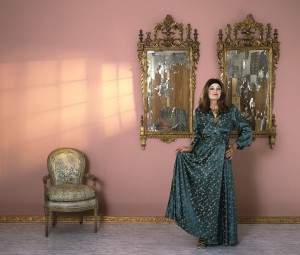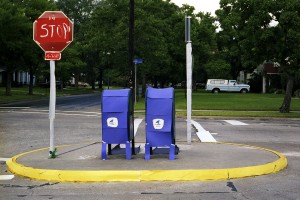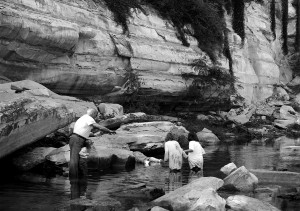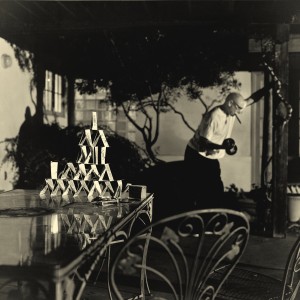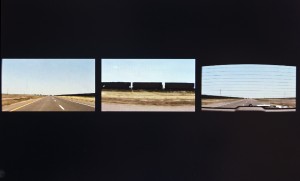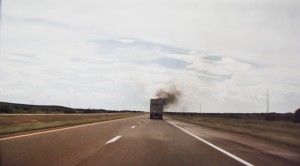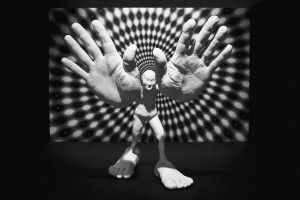
The Cast (Ms. D'Avignon), 1985
On the Set, Close to Home
Nic Nicosia, (Austin: University of Texas Press, 2012) the 256-page survey of Nicosia’s printed and moving images, is where one will see contemporaneously the depth and breadth of his work. The book’s value and pleasure lie in the variety of Nicosia’s 32-year production, framed like a portable retrospective, chronologically in series including Domestic Drama, Near Modern Disasters, The Cast, and I See Light (but not “I See The Light”).
Nicosia composes his pictures using actors and objects in chosen settings and within sets that he constructs. From 1981, for two decades on, he fictionalizes conventional photographic types — landscape, document, portrait, film or theater still — into disrupted imagery tinting normalcy with the uncanny. The work nudges the viewer to question his place in the world. Following his 2004 move from hometown Dallas to Santa Fe, Nicosia’s work begins exploring nature, as well as his identity and psychic states.
The pictures in the book lie iron-on flat upon the page. Nicosia printed the originals on photographic paper, cinematic film, magnetic tape, or with digital plotters. Since the book format neutralizes these object distinctions, the editors fortunately follow the plates with a glossary to media, dimensions and provenance.
Interviewed by Sue Graze, curator emeritus of Austin’s Arthouse (now AMOA), Nicosia acknowledges his youthful intuition and ease with camera and set, relating that, “On the first day of TV class (at University of North Texas, Denton) I was placed behind a huge, studio TV camera….and found it to be the most natural and comfortable thing I had ever experienced”.
His art passes through the camera but to call it photography is categorically constrained, if not a shortchange, since the effort and imagination of its making lie largely outside the effort and imagination of photography.
Instead of aestheticizing a subject or stopping time, Nicosia’s pictures begin with a constructed instant. The camera is not a Weegee-type recorder. Instead it’s a chamber where fictions gestate and are born as events that could not develop elsewhere.
Mailboxes (1980), finds Nicosia fingering the thin line between art and life, in a whoop on plein-air painting and a hat tip to “environmental” art. He forays into his neighborhood roadway to patch over a circular island with swatches of colored background paper, mailbox blue for a pair of mailboxes, caution yellow for the curb, exact red for the stop sign. Had this been land art, the ensuing photo would have documented an intervention, perhaps a satire on suburban tranquility, but here the scene-making is ephemeral. Nicosia dumpsters the materials at shoot’s end. The picture buzzes with performance but the artist has exited the stage.
Here’s the break with the previous generation of land artists. Robert Smithson’s Spiral Jetty (1973) imagines a schizoid journey to America, with the riprap that extends into the Great Salt Lake connoting a trans-ocean passage, while the in-coiling spiral traces a route to the interior — the self.
Nicosia’s work illuminates that path to the interior, his characters inhabiting scenes as comfortably as they would a thrift-store suit.
For “Ms. D’Avignon,” one of The Cast series (1985), Nicosia concocts a pseudo-publicity shot of a wrung-out belle flanked by mirrors with their mercury peeling off, clocking the genre as memento of transient beauty.
An image from documentary-styled Real Pictures evokes Raymond Carver’s story “So Much Water So Close To Home,” where some guys spend a weekend fishing in the company of a drowned corpse. Three little girls and a middle-aged man, pulled between curiosity and alarm, wade up to a body snagged in the boulders below a precipitous riverbank. Staged with family and friends and a blow-up doll, the setting is a haunt of the artist’s childhood in Dallas’s Bluffs neighborhood, where the hapless occasionally launched off a cliff into the stream and drowned. Nicosia constructs the shot as if impersonating a cameraman, but it’s the viewer who is looking on.
Nicosia’s 30-year breadth suggests that he’s not conclusively figuring something out; rather he’s getting to a place, then moving on. The 2003 road video 9.5 Hours to Santa Fe, is a long picture — tied by its confabulation of dimension and duration to Warhol’s Empire, a tall one.
In the most recent work (2010-2012), Nicosia sculpts naked and distorted figures; they express a limbo of anxiety and contemplation. In “Concentration in Bits” (2011), a nude with eyes closed wards off an unseen force with gigantic hands. The figure in “And the Ego Goes Where?”(2010) stands naked in a set that like a Tarot card hems him in by a forest of poles. Costumes, architecture, decoration and genre signifiers slough off. The sets become backgrounds leaving the pictures to project subjective states. The handmade figure accentuates psychic rawness.
Studying this survey one may recognize that Nicosia finds modes within which to work. Like a miner, he follows the vein where it takes him, even in the dark. It’s up to the reader to tease out the patterns and meanings. From work over 30 years ago that reveals his youthful appetite for set-building to pictures now that reveal how it is ultimately the self which steps into the harsh light of artistic exploration, this book is the best guide yet to Nic Nicosia’s art.

